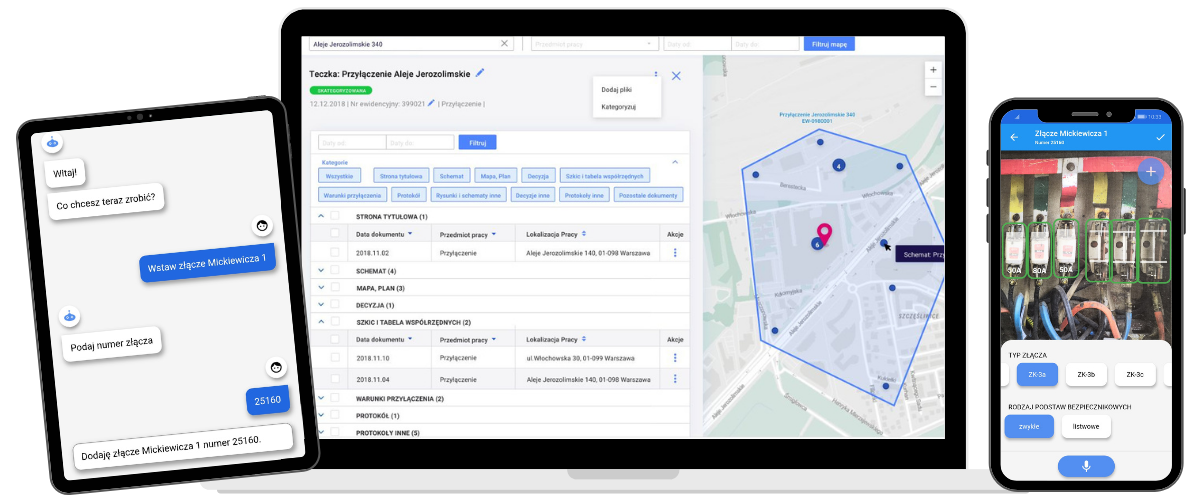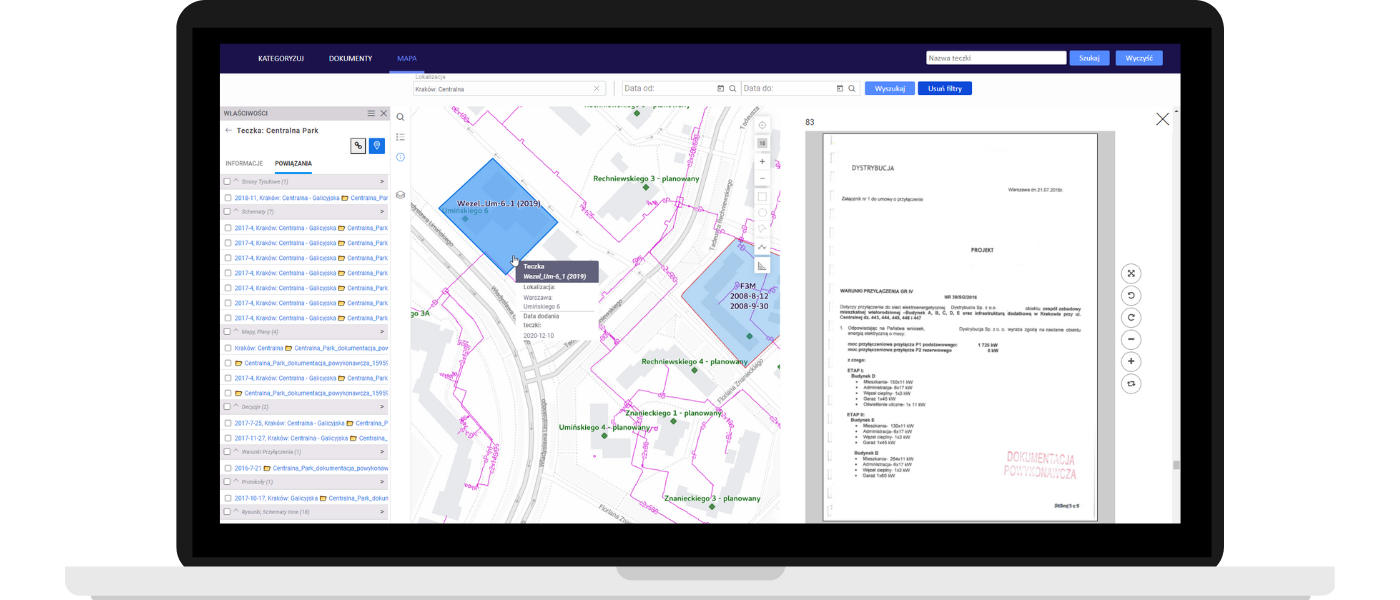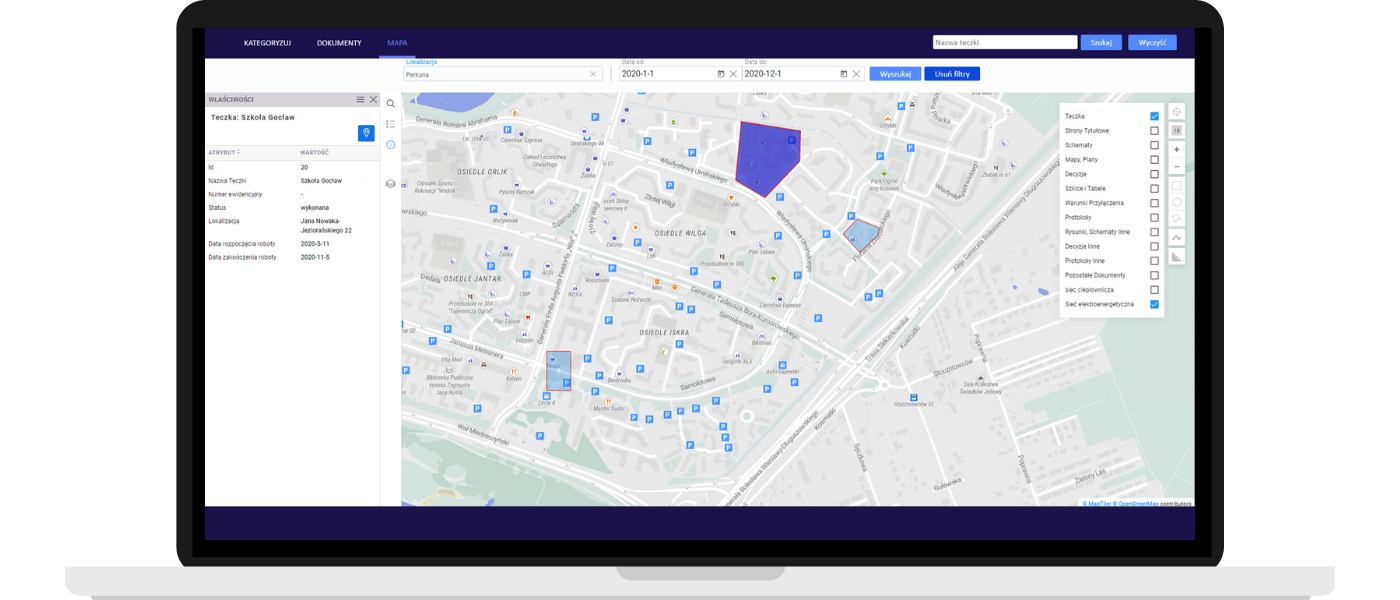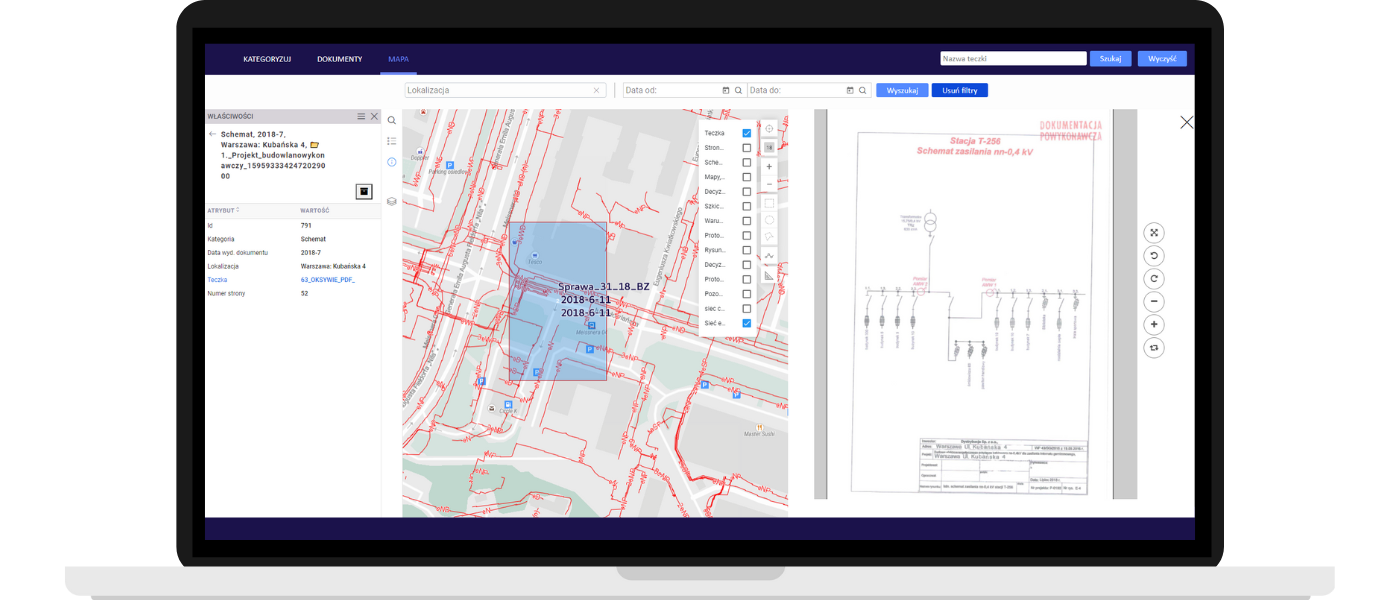
Every investment added to an energy, water, telco, or other utility network is related to creating as-built documentation. Such documentation contains basic information about e.g. location, type, and start/end date of an investment, as well as a description of newly built objects and other crucial data.
It might happen that during the process of determining the grid connection conditions or planning the network modernization you need to access information about the network. It seems like the as-built technical documentation is a perfect source of such knowledge. All you have to do is to take a look inside the documents and you can get to work…
…in theory.
In practice, this first step – obtaining up-to-date information – can be the hardest one. A lot of it depends on the availability of the technical documentation and whether it’s easy to freely search for information contained in it. The key factor is how you archive your documents.
Documentation in the paper version
A lot of companies, especially those established many years ago, own their technical documentation in the paper version. This is common for organizations in sectors such as telecommunications, energy, or district heating. They own copious amounts of documents in their archives; thousands of pages are stored in countless folders, and their length can total hundreds of meters.
Let’s assume a perfect situation: carefully archived, cataloged, and labeled documents that always go back to their place. Still, finding the right folder and then the right document can be complicated and time-consuming.
If more than one person has to use paper documents, it’s easy to lose or tear down pages. In some companies, documentation goes back to the ‘70s, and with such huge archives, all it takes to lose a folder is to put it back in the wrong place. Moreover, companies with so many documents find it difficult to determine their scope and whether they miss any data.

Single physical copies make it hard to use documents and require employees to visit the repository in person to retrieve them. This entire process is time-consuming, additionally, verifying further information creates a need for the next visits to the archives.
Considering the effort related to obtaining the needed information, it often turns out that documents are not used at all. In this case, the value of the data contained in the documentation remains theoretic. This is just like collecting information with no means to understand them or conducting a study without analyzing results.
Scans – a digital repository for beginners
A simple scan of documents and moving files onto a shared disc increases data availability. Every employee can reach them via the Internet with no need for visiting archives. This removes limitations of availability and the number of people that can use documents at the same time.
Documents also don’t need to be copied which limits costs and the use of paper. Moreover, the risk of the destruction of the single existing copies is minimal. Even if the paper documentation is destroyed in flooding or fire, it doesn’t result in an irreversible loss of data collected throughout the years.
One of the challenges of this type of archiving is the right protection of the sensitive data stored in the internal network. It’s extremely important to put the catalogs and files in the right order and configure access levels for different roles, people, departments, etc.
Manual digitization is the process of scanning and categorizing hundreds of document pages. It’s also time-consuming and therefore, costly. So instead of committing valuable work time to manually create a digital archive, the company may decide to scan only a part of the documentation. As a result, employees get wide access only to an arbitrarily selected fragment of information.

Let’s move a step further – LocDoc, a spatial documentation database created with artificial intelligence
LocDoc solution was created specifically for technical network documentation and it uses artificial intelligence (AI) and specialized algorithms for automatically analyzing, categorizing, and arranging information contained in the scanned documents.
Are there other options than paper and simple pdf file repositories? Quite a popular solution among companies is a Data Management System (DMS) for managing the information flow process. Such systems provide access to the information within the scanned files but the range of supported documents is very limited. They mostly support invoices and some types of agreements, so they won’t work well in every case, like for technical network documentation.
Thanks to the AI algorithms you can quickly create a digital archive of the technical documentation. It can be available at any time to every person of interest: a company employee, a subcontractor, or a receiver of electricity or gas searching for information about their agreement.
How does LocDoc work?
Since LocDoc uses information about locations, it creates a spatial database of documentation. This means that documents within this database are assigned to geographical coordinates or investment addresses and they can be accessed through a map. When analyzing data within documentation, LocDoc groups them according to three main categories:
Document type
The AI model inside the LocDoc application reads the contents of a scanned as-built documentation file and defines its category without human assistance. It recognizes technical documents such as grid connection conditions, maps, internal schemes, field sketches, coordinate tables, decisions, protocols, title pages, notarial acts, or agreements.
If there is another document type that LocDoc doesn’t recognize yet, nothing prevents us from training it to handle this new type. We only need the right number of documents of this type.
Investment date
The date of creation or issuance of a given document is crucial information. But how do you retrieve those when many other dates are appearing in the contents, such as a decision date or service provision date?
The artificial intelligence algorithm deals with this issue highly effectively. In this situation, a person only needs to verify and accept unclear cases.
LocDoc distinguishes which of the dates contained in a document are related to the beginning and end of the investment. Moreover, it’s able to determine the length of the investment and whether it hasn’t been finished yet.
Investment location
An investment location can be determined in two ways: according to the postal address or a plot and area number. The application finds the right plot location among other addresses and locations that usually appear in documents, for example, the contractor’s or construction supervisor’s addresses. After LocDoc recognizes the plot location, it assigns it to the right document.
The application can also transform this information into geographic coordinates and display the investment location on a map in form of a point or an area.
How efficient is LocDoc in comparison to manual data processing?
For a human, the average time of performing the above process of reading and categorizing information manually takes about 50 seconds per page. Additionally, after reading a document, a person needs to catalog it, either in a physical or digital form.
The same process performed automatically by LocDoc takes 5 seconds on average, including cataloging. Moreover, the application automatically builds a database. This means that automated categorization is about 10 times faster than categorization performed by a human.
Contrary to humans, machines never get tired, therefore, LocDoc maintains its reading and categorizing efficiency and accuracy of 95% no matter how long it runs. A person is necessary to verify the data’s accuracy and apply potential corrections.
Categorization – human vs LocDoc
manual categorization
automated categorization
is how much LocDoc is faster than a human
LocDoc’s accuracy
To sum up, LocDoc provides fast access to up-to-date, reliable information about investments. Documents can be easily searched for using their dates or locations. They can be also found on a map, by clicking on a spot with a folder icon.
A found document can also be viewed and sent through a link to another person that needs it, whether in the office or out in the field. This is way faster than searching for the right document on shelves and putting them away in their place. Digital documentation cause no problems related to their availability, there’s also no risk of the contents being lost or destroyed.
This type of data storage is much safer, additionally, LocDoc meets the newest safety requirements for storing information as well as Application Security Verification Standards (ASVS).
Do you like this article? Want to receive fresh news on your mail box?
Join our newsletter
and stay up-to-date!

How does using a digital document database improve your work?
There are many situations when free access to up-to-date network information improves work directly or indirectly. We’re going to describe two examples: planning modernizations and new investments as well as maintaining the network.
Planning modernizations and new investments
A quick view into network documentation as well as having a full network image all in one place are irreplaceable when planning modernizations, investments, and repairs. When planning and designing a new network, convenient access to information about the current network course and its parameters is equally important. It helps to determine connections between the new and existing networks.
Documentation presented on a map also gives clear insights into which plots have already been assigned their grid connection conditions and which plots are still missing them, prolonging the entire investment process.
The moment right after finalizing the investment is also important. It’s when all information about the new network devices collected in the technical documentation is moved (transcribed manually by people) to their databases, files, or applications. Finding the right map with geometric data about the new part of the network or a protocol with descriptive data about the installed devices is much easier and faster in the LocDoc base than in a cabinet with folders.
Network maintenance
Digitized documents give you quick access to information about any type of work performed within a network. This information includes dates and parties responsible for work. This provides basic but important information about the network course, the location of its specific elements, as well as the types, locations, and parameters of the network devices.
If such a device is subject to a breakdown, you instantly know what tools and resources are needed during repairs. This kind of information also makes it easy to plan necessary inspections and maintenance works.
Benefits of document digitization
Fast and convenient access to the network information available for many people at the same time and any moment facilitates and accelerates many activities and business processes. Normally, they would take much longer due to limited access to documents.
Many people can use the same resources simultaneously: during remote work, meeting clients out of the office, and during regular internal company meetings.
This is a big improvement for all people whose work is related to networks – technical crews taking care of operations and maintenance, crews that plan new investments, customer service department employees, and others.
Improved access to data creates an opportunity to complete more tasks in a shorter time, so it results in more satisfied clients and larger profit (or lower costs).
The digital archive can be a step toward building a digital model of network assets and implementing a network inventory system that gives a complete picture of the network, its components, and processes in real time.
LocDoc is an important step on the road to the full digitization of network data in network record/network inventory systems. It provides efficient navigation of documents (even historical ones), allowing you to:
- trace the building history of the object
- identify the most current attributes
- link network objects to each other

Due to costs, even in companies that implemented an asset management system, not all information from the records is transferred to the digital model. Then there is a need to go to the full documentation, i.e. looking in paper archives for older studies or folders from investments.
The integration of the network inventory system with LocDoc prevents such scenarios, as each document, along with a preview of its contents, can be accessed in only two clicks.
iDoc – data in a digital archive up to 10 times faster
iDoc is an extension of the LocDoc service that automatically reads a wide range of data from documents. Object data contained in as-built maps, internal schematics of objects, final reports, tables, and other types of documents are normally entered into a company’s database manually. iDoc automates this process by reading and entering these data into a database.
With iDoc, data enters the system up to 10 times faster and of higher quality, with the person only needed to handle the final verification and approval. You can read more about iDoc and how to use it to read data from contracts in the article “How to improve paper document digitization? Creating data archives using Artificial Intelligence”
The iDoc service can be tailored to the requirements and specifications of many industries as well as particular companies. One of them is the energy industry. Together with STOEN, we worked on a project that used AI models for reading the information contained in documents and grouping them according to objects within the energy network together with their attributes. An example would be an energy station with its unique name, voltage level, station type, etc.


iDoc and LocDoc are a part of the GlobIQ platform for building and maintaining digital network asset models.
Do you want do talk about digitizing documents in your company?
Contact us and schedule a free consultation. Our experts will be happy to share their experience and advise you on which solution will work for your business.













